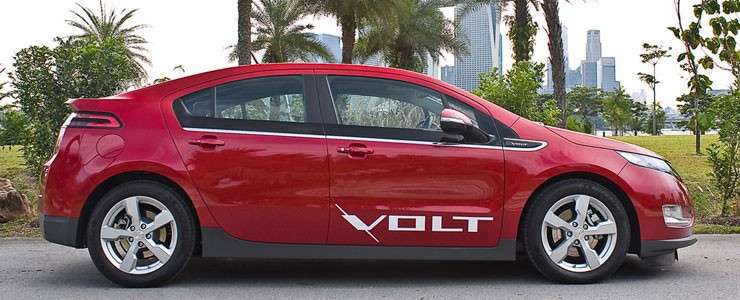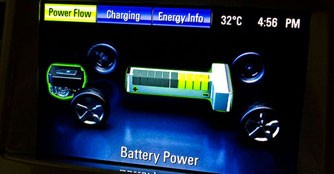Chevrolet Volt (A) Review
07 Nov 2012|30,151 views
The concept Chevrolet Volt was first seen years back in 2007 at the North American Auto Show and it was the first ever series plug-in hybrid concept car shown by a major carmaker then. Of course there was a significant change in its design when compared to the General Motors EV1 of the 90s, which only sat two for the sake of reducing weight.
One of the key design decisions was to develop the concept Volt based on a new family of common powertrain components for electric propulsion, which was initially called the E-Flex Systems - 'E' stands for Electric drive and 'Flex' for the different sources of electricity.
But it was later renamed Voltec drive system. This Voltec platform is an attempt to standardise many components of possible future electrically propelled vehicles, and to allow multiple interchangeable electricity-generating systems. It wasn't until October 2006 when the this platform was selected for the new propulsion architecture and the name Volt was chosen by General Motors.
The production model that you see here was first unveiled two years later in 2008 and it wasn't until the end of 2010 when the production of the car finally started.
In a way, the Volt is a technological wonder that combines the ability to drive on electric power only, while its internal combustion engine relieves the range anxiety often associated with pure-electric cars. Instead of driving the front wheels, the petrol powers the generator motor which recharges the batteries to power the drive motor.
In fact, absent some of the interior styling and information displays, you will never know that the Volt has a revolutionary electric powertrain. If you never plug it in, it will pot around happily on its 1.4-litre engine for as long as you keep filling the tank (35.2 litres big to be exact).
One of the key design decisions was to develop the concept Volt based on a new family of common powertrain components for electric propulsion, which was initially called the E-Flex Systems - 'E' stands for Electric drive and 'Flex' for the different sources of electricity.
But it was later renamed Voltec drive system. This Voltec platform is an attempt to standardise many components of possible future electrically propelled vehicles, and to allow multiple interchangeable electricity-generating systems. It wasn't until October 2006 when the this platform was selected for the new propulsion architecture and the name Volt was chosen by General Motors.
The production model that you see here was first unveiled two years later in 2008 and it wasn't until the end of 2010 when the production of the car finally started.
In a way, the Volt is a technological wonder that combines the ability to drive on electric power only, while its internal combustion engine relieves the range anxiety often associated with pure-electric cars. Instead of driving the front wheels, the petrol powers the generator motor which recharges the batteries to power the drive motor.
In fact, absent some of the interior styling and information displays, you will never know that the Volt has a revolutionary electric powertrain. If you never plug it in, it will pot around happily on its 1.4-litre engine for as long as you keep filling the tank (35.2 litres big to be exact).
 |
Once fully charged up, the Chevy Volt will run for about 55 - 60km (depending on how hard you drive it) before the battery is depleted. But where it gets interesting is when the afore mentioned 1.4-litre gasoline engine 'takes charge' as a range extender. With this range extender running, you can easily go for another 410km - totalling the drive range that's close to 500km.
 |
Exterior
The looks of the production Volt is a far cry from the long, robotic shape of the 2007 concept car. Still, it remains to be distinctive, thanks to its rather futuristic looks and low-slung sporty stance. The Volt looks almost like any sedan on the road, only better-looking. But it's only when you get up close and personal can you spot the closed front grille. Although quirky and toy-like, the blocked off grille, according to Chevrolet, helps to improve aerodynamics.
The rear appears a little complicated, with piano black outlines extending out from the boot to the tail lights. But it's also the rear that gives the Volt some brawny feel to it. The lines are nicely angled while the spoiler provides the car with the necessary dynamism and athletic looks.
Measuring at 4,498mm x 2,126mm x 1,439mm (L x W x H), the Chevrolet Volt is shorter, lower and wider than the Renault Fluence Z.E. As a result, it catches the attention of many as you zip in and out of traffic foolishly but confidently.
Interior
Here, the first thing that catches your eye is a cockpit that's way ahead of its time. The gloss white centre stack packs a confusing array of technology overload with a bunch of touch buttons that glow in alien green hue at night but they are easy to identify and differentiate.
The looks of the production Volt is a far cry from the long, robotic shape of the 2007 concept car. Still, it remains to be distinctive, thanks to its rather futuristic looks and low-slung sporty stance. The Volt looks almost like any sedan on the road, only better-looking. But it's only when you get up close and personal can you spot the closed front grille. Although quirky and toy-like, the blocked off grille, according to Chevrolet, helps to improve aerodynamics.
The rear appears a little complicated, with piano black outlines extending out from the boot to the tail lights. But it's also the rear that gives the Volt some brawny feel to it. The lines are nicely angled while the spoiler provides the car with the necessary dynamism and athletic looks.
Measuring at 4,498mm x 2,126mm x 1,439mm (L x W x H), the Chevrolet Volt is shorter, lower and wider than the Renault Fluence Z.E. As a result, it catches the attention of many as you zip in and out of traffic foolishly but confidently.
Interior
Here, the first thing that catches your eye is a cockpit that's way ahead of its time. The gloss white centre stack packs a confusing array of technology overload with a bunch of touch buttons that glow in alien green hue at night but they are easy to identify and differentiate.
What we do like the most is the clear and informative screen. It organises and displays a wealth of information clearly and accurately with a press of a button (that has a leaf engraved on it). It basically tells you what happens during braking and acceleration and keeps you informed of the battery state of charge and remaining range while you door-handle the car like a mad man.
While the Volt triumphs other electric cars without having the problem of 'range anxiety', it loses to the Renault Fluence Z.E in terms of sitting capacity. The Chevy seats four rather than five passengers due to the central tunnel that runs from the front console to the rear seat that houses the car's 16kWh lithium-ion T-shaped battery pack. But it's a forgivable flaw considering that all four occupants get to enjoy ample space all round in comfort.
And while 310 litres of boot space may seem inadequate on paper, it does look sizeable in real life (as you can see here) and can be increased by a couple of notches to 1,005 litres with the rear seats knocked down.
The cabin looks well crafted and well pieced together, with materials looking upscale. In fact it's these materials that seem to be the best yet from recently launched Chevrolets.
While the Volt triumphs other electric cars without having the problem of 'range anxiety', it loses to the Renault Fluence Z.E in terms of sitting capacity. The Chevy seats four rather than five passengers due to the central tunnel that runs from the front console to the rear seat that houses the car's 16kWh lithium-ion T-shaped battery pack. But it's a forgivable flaw considering that all four occupants get to enjoy ample space all round in comfort.
And while 310 litres of boot space may seem inadequate on paper, it does look sizeable in real life (as you can see here) and can be increased by a couple of notches to 1,005 litres with the rear seats knocked down.
The cabin looks well crafted and well pieced together, with materials looking upscale. In fact it's these materials that seem to be the best yet from recently launched Chevrolets.
 |
The Drive
Figures wise, the Volt has an output of 111kW (which is equivalent to about 150bhp) and a generous amount of 370Nm of torque. While the 370Nm isn't mountain moving on paper, it is when you're driving it. As this is an electric motor that we're talking about, all of that torque is on tap from zero rpm, giving the Volt an impressive get-up-and-go attitude. It literally accelerates off the line with immediate urgency and little fuss right from the word go.
This electric Chevy features four different drive modes that are selectable via a button on the centre stack. By default, you get the usual Normal mode which is also the most economical mode. Then there is a Sport mode that enhances the car's acceleration and tightens the suspension. The sheer acceleration power of the Volt isn't eye-popping but it's certainly quick enough to tingle your senses. Slam the right pedal down and the Volt lunges forward in a poised manner while making a slight wheezing noise to remind you that it's an electric car you driving.
There is also an oddly named Mountain mode that doesn't seem to cause any difference in terms of the drive and another one called the Hold mode. Unlike what the name suggests, it doesn't act as an auto hold function like how some of the luxurious brands offer but it starts drawing power from the range extender even if the battery isn't depleted.
Figures wise, the Volt has an output of 111kW (which is equivalent to about 150bhp) and a generous amount of 370Nm of torque. While the 370Nm isn't mountain moving on paper, it is when you're driving it. As this is an electric motor that we're talking about, all of that torque is on tap from zero rpm, giving the Volt an impressive get-up-and-go attitude. It literally accelerates off the line with immediate urgency and little fuss right from the word go.
This electric Chevy features four different drive modes that are selectable via a button on the centre stack. By default, you get the usual Normal mode which is also the most economical mode. Then there is a Sport mode that enhances the car's acceleration and tightens the suspension. The sheer acceleration power of the Volt isn't eye-popping but it's certainly quick enough to tingle your senses. Slam the right pedal down and the Volt lunges forward in a poised manner while making a slight wheezing noise to remind you that it's an electric car you driving.
There is also an oddly named Mountain mode that doesn't seem to cause any difference in terms of the drive and another one called the Hold mode. Unlike what the name suggests, it doesn't act as an auto hold function like how some of the luxurious brands offer but it starts drawing power from the range extender even if the battery isn't depleted.
Despite its weight of over 1.7 tonnes, the Volt drives and handles well too. You get a fistful of communicativeness at the helm, with steering inputs translated into accurate directional changes as it delightfully carves the contours and corners. What it does lack, though, is a slightly heavier weight for better feedback. More impressively, the Volt rides quietly and comfortably as it resists the effects of uneven surfaces and broken asphalts allowing the driver to maintain a grip on the road without any fuss.
For an electric car that possesses a rather complex power train, the driving experience of the Volt is surprisingly simple and quiet, even when the gas engine kicks in when the battery is depleted. The single-speed transmission also means that there's no jerky shifting and no interruption of power as you accelerate.
Conclusion
The Volt is nothing less than an amazing piece of engineering. It could have been, honestly, the ideal tree-hugging car if it weren't for its staggering price tag. Good thing is going green with the Volt doesn't require you to sacrifice performance. Plus, most comparable cars (electric and non-electric) fall short of the technology the Volt includes.
For buyers who are interested in the Volt and have got $220,000 to spare, you can place an order for the car now.
For an electric car that possesses a rather complex power train, the driving experience of the Volt is surprisingly simple and quiet, even when the gas engine kicks in when the battery is depleted. The single-speed transmission also means that there's no jerky shifting and no interruption of power as you accelerate.
Conclusion
The Volt is nothing less than an amazing piece of engineering. It could have been, honestly, the ideal tree-hugging car if it weren't for its staggering price tag. Good thing is going green with the Volt doesn't require you to sacrifice performance. Plus, most comparable cars (electric and non-electric) fall short of the technology the Volt includes.
For buyers who are interested in the Volt and have got $220,000 to spare, you can place an order for the car now.
The concept Chevrolet Volt was first seen years back in 2007 at the North American Auto Show and it was the first ever series plug-in hybrid concept car shown by a major carmaker then. Of course there was a significant change in its design when compared to the General Motors EV1 of the 90s, which only sat two for the sake of reducing weight.
One of the key design decisions was to develop the concept Volt based on a new family of common powertrain components for electric propulsion, which was initially called the E-Flex Systems - 'E' stands for Electric drive and 'Flex' for the different sources of electricity.
But it was later renamed Voltec drive system. This Voltec platform is an attempt to standardise many components of possible future electrically propelled vehicles, and to allow multiple interchangeable electricity-generating systems. It wasn't until October 2006 when the this platform was selected for the new propulsion architecture and the name Volt was chosen by General Motors.
The production model that you see here was first unveiled two years later in 2008 and it wasn't until the end of 2010 when the production of the car finally started.
In a way, the Volt is a technological wonder that combines the ability to drive on electric power only, while its internal combustion engine relieves the range anxiety often associated with pure-electric cars. Instead of driving the front wheels, the petrol powers the generator motor which recharges the batteries to power the drive motor.
In fact, absent some of the interior styling and information displays, you will never know that the Volt has a revolutionary electric powertrain. If you never plug it in, it will pot around happily on its 1.4-litre engine for as long as you keep filling the tank (35.2 litres big to be exact).
One of the key design decisions was to develop the concept Volt based on a new family of common powertrain components for electric propulsion, which was initially called the E-Flex Systems - 'E' stands for Electric drive and 'Flex' for the different sources of electricity.
But it was later renamed Voltec drive system. This Voltec platform is an attempt to standardise many components of possible future electrically propelled vehicles, and to allow multiple interchangeable electricity-generating systems. It wasn't until October 2006 when the this platform was selected for the new propulsion architecture and the name Volt was chosen by General Motors.
The production model that you see here was first unveiled two years later in 2008 and it wasn't until the end of 2010 when the production of the car finally started.
In a way, the Volt is a technological wonder that combines the ability to drive on electric power only, while its internal combustion engine relieves the range anxiety often associated with pure-electric cars. Instead of driving the front wheels, the petrol powers the generator motor which recharges the batteries to power the drive motor.
In fact, absent some of the interior styling and information displays, you will never know that the Volt has a revolutionary electric powertrain. If you never plug it in, it will pot around happily on its 1.4-litre engine for as long as you keep filling the tank (35.2 litres big to be exact).
Once fully charged up, the Chevy Volt will run for about 55 - 60km (depending on how hard you drive it) before the battery is depleted. But where it gets interesting is when the afore mentioned 1.4-litre gasoline engine 'takes charge' as a range extender. With this range extender running, you can easily go for another 410km - totalling the drive range that's close to 500km.
Exterior
The looks of the production Volt is a far cry from the long, robotic shape of the 2007 concept car. Still, it remains to be distinctive, thanks to its rather futuristic looks and low-slung sporty stance. The Volt looks almost like any sedan on the road, only better-looking. But it's only when you get up close and personal can you spot the closed front grille. Although quirky and toy-like, the blocked off grille, according to Chevrolet, helps to improve aerodynamics.
The rear appears a little complicated, with piano black outlines extending out from the boot to the tail lights. But it's also the rear that gives the Volt some brawny feel to it. The lines are nicely angled while the spoiler provides the car with the necessary dynamism and athletic looks.
Measuring at 4,498mm x 2,126mm x 1,439mm (L x W x H), the Chevrolet Volt is shorter, lower and wider than the Renault Fluence Z.E. As a result, it catches the attention of many as you zip in and out of traffic foolishly but confidently.
Interior
Here, the first thing that catches your eye is a cockpit that's way ahead of its time. The gloss white centre stack packs a confusing array of technology overload with a bunch of touch buttons that glow in alien green hue at night but they are easy to identify and differentiate.
The looks of the production Volt is a far cry from the long, robotic shape of the 2007 concept car. Still, it remains to be distinctive, thanks to its rather futuristic looks and low-slung sporty stance. The Volt looks almost like any sedan on the road, only better-looking. But it's only when you get up close and personal can you spot the closed front grille. Although quirky and toy-like, the blocked off grille, according to Chevrolet, helps to improve aerodynamics.
The rear appears a little complicated, with piano black outlines extending out from the boot to the tail lights. But it's also the rear that gives the Volt some brawny feel to it. The lines are nicely angled while the spoiler provides the car with the necessary dynamism and athletic looks.
Measuring at 4,498mm x 2,126mm x 1,439mm (L x W x H), the Chevrolet Volt is shorter, lower and wider than the Renault Fluence Z.E. As a result, it catches the attention of many as you zip in and out of traffic foolishly but confidently.
Interior
Here, the first thing that catches your eye is a cockpit that's way ahead of its time. The gloss white centre stack packs a confusing array of technology overload with a bunch of touch buttons that glow in alien green hue at night but they are easy to identify and differentiate.
What we do like the most is the clear and informative screen. It organises and displays a wealth of information clearly and accurately with a press of a button (that has a leaf engraved on it). It basically tells you what happens during braking and acceleration and keeps you informed of the battery state of charge and remaining range while you door-handle the car like a mad man.
While the Volt triumphs other electric cars without having the problem of 'range anxiety', it loses to the Renault Fluence Z.E in terms of sitting capacity. The Chevy seats four rather than five passengers due to the central tunnel that runs from the front console to the rear seat that houses the car's 16kWh lithium-ion T-shaped battery pack. But it's a forgivable flaw considering that all four occupants get to enjoy ample space all round in comfort.
And while 310 litres of boot space may seem inadequate on paper, it does look sizeable in real life (as you can see here) and can be increased by a couple of notches to 1,005 litres with the rear seats knocked down.
The cabin looks well crafted and well pieced together, with materials looking upscale. In fact it's these materials that seem to be the best yet from recently launched Chevrolets.
While the Volt triumphs other electric cars without having the problem of 'range anxiety', it loses to the Renault Fluence Z.E in terms of sitting capacity. The Chevy seats four rather than five passengers due to the central tunnel that runs from the front console to the rear seat that houses the car's 16kWh lithium-ion T-shaped battery pack. But it's a forgivable flaw considering that all four occupants get to enjoy ample space all round in comfort.
And while 310 litres of boot space may seem inadequate on paper, it does look sizeable in real life (as you can see here) and can be increased by a couple of notches to 1,005 litres with the rear seats knocked down.
The cabin looks well crafted and well pieced together, with materials looking upscale. In fact it's these materials that seem to be the best yet from recently launched Chevrolets.
The Drive
Figures wise, the Volt has an output of 111kW (which is equivalent to about 150bhp) and a generous amount of 370Nm of torque. While the 370Nm isn't mountain moving on paper, it is when you're driving it. As this is an electric motor that we're talking about, all of that torque is on tap from zero rpm, giving the Volt an impressive get-up-and-go attitude. It literally accelerates off the line with immediate urgency and little fuss right from the word go.
This electric Chevy features four different drive modes that are selectable via a button on the centre stack. By default, you get the usual Normal mode which is also the most economical mode. Then there is a Sport mode that enhances the car's acceleration and tightens the suspension. The sheer acceleration power of the Volt isn't eye-popping but it's certainly quick enough to tingle your senses. Slam the right pedal down and the Volt lunges forward in a poised manner while making a slight wheezing noise to remind you that it's an electric car you driving.
There is also an oddly named Mountain mode that doesn't seem to cause any difference in terms of the drive and another one called the Hold mode. Unlike what the name suggests, it doesn't act as an auto hold function like how some of the luxurious brands offer but it starts drawing power from the range extender even if the battery isn't depleted.
Figures wise, the Volt has an output of 111kW (which is equivalent to about 150bhp) and a generous amount of 370Nm of torque. While the 370Nm isn't mountain moving on paper, it is when you're driving it. As this is an electric motor that we're talking about, all of that torque is on tap from zero rpm, giving the Volt an impressive get-up-and-go attitude. It literally accelerates off the line with immediate urgency and little fuss right from the word go.
This electric Chevy features four different drive modes that are selectable via a button on the centre stack. By default, you get the usual Normal mode which is also the most economical mode. Then there is a Sport mode that enhances the car's acceleration and tightens the suspension. The sheer acceleration power of the Volt isn't eye-popping but it's certainly quick enough to tingle your senses. Slam the right pedal down and the Volt lunges forward in a poised manner while making a slight wheezing noise to remind you that it's an electric car you driving.
There is also an oddly named Mountain mode that doesn't seem to cause any difference in terms of the drive and another one called the Hold mode. Unlike what the name suggests, it doesn't act as an auto hold function like how some of the luxurious brands offer but it starts drawing power from the range extender even if the battery isn't depleted.
Despite its weight of over 1.7 tonnes, the Volt drives and handles well too. You get a fistful of communicativeness at the helm, with steering inputs translated into accurate directional changes as it delightfully carves the contours and corners. What it does lack, though, is a slightly heavier weight for better feedback. More impressively, the Volt rides quietly and comfortably as it resists the effects of uneven surfaces and broken asphalts allowing the driver to maintain a grip on the road without any fuss.
For an electric car that possesses a rather complex power train, the driving experience of the Volt is surprisingly simple and quiet, even when the gas engine kicks in when the battery is depleted. The single-speed transmission also means that there's no jerky shifting and no interruption of power as you accelerate.
Conclusion
The Volt is nothing less than an amazing piece of engineering. It could have been, honestly, the ideal tree-hugging car if it weren't for its staggering price tag. Good thing is going green with the Volt doesn't require you to sacrifice performance. Plus, most comparable cars (electric and non-electric) fall short of the technology the Volt includes.
For buyers who are interested in the Volt and have got $220,000 to spare, you can place an order for the car now.
For an electric car that possesses a rather complex power train, the driving experience of the Volt is surprisingly simple and quiet, even when the gas engine kicks in when the battery is depleted. The single-speed transmission also means that there's no jerky shifting and no interruption of power as you accelerate.
Conclusion
The Volt is nothing less than an amazing piece of engineering. It could have been, honestly, the ideal tree-hugging car if it weren't for its staggering price tag. Good thing is going green with the Volt doesn't require you to sacrifice performance. Plus, most comparable cars (electric and non-electric) fall short of the technology the Volt includes.
For buyers who are interested in the Volt and have got $220,000 to spare, you can place an order for the car now.
Car Information
Chevrolet Volt 111kWh (A)
CAT B|Petrol|n/a
Horsepower
112kW (150 bhp)
Torque
130 Nm
Acceleration
9sec (0-100km /hr)
This model is no longer being sold by local distributor
All Used Chevrolet VoltThank You For Your Subscription.






























































